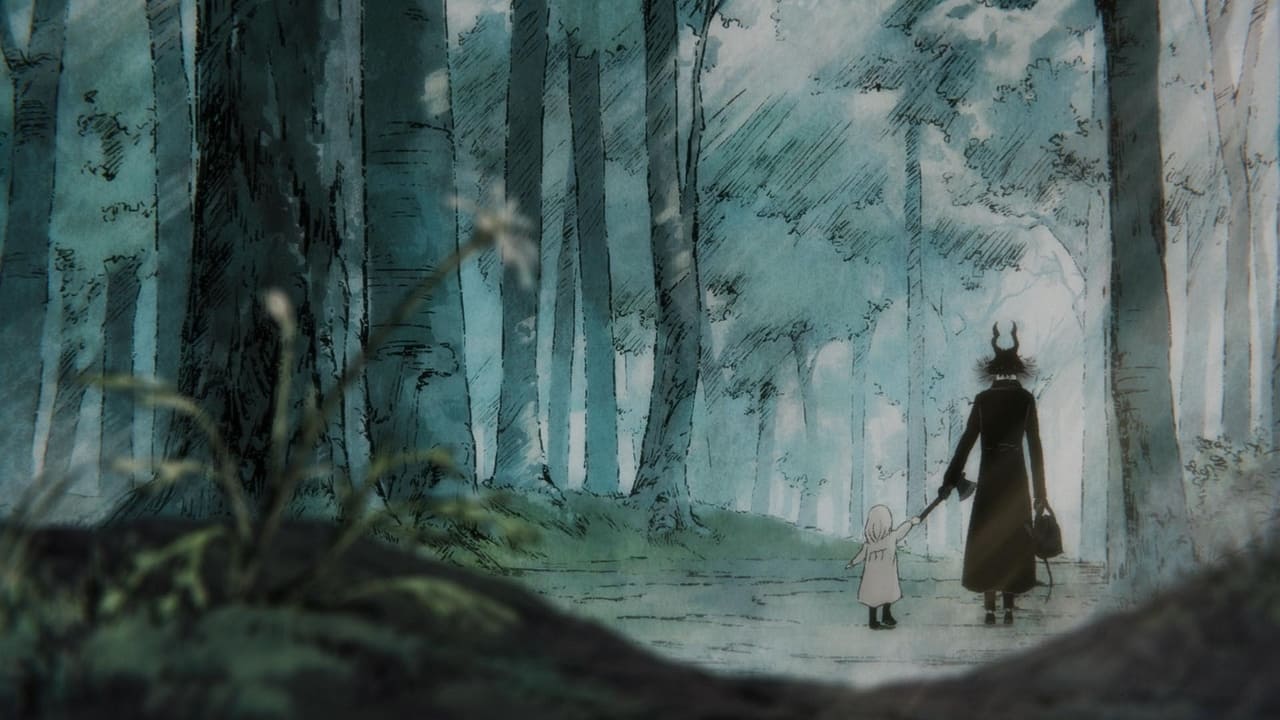Simultaneously emulating a sense of wonder and dread in classic, gothic forms, The Girl From the Other Side is a masterful expression of loneliness and the compassion of being seen.
Based on their 2019 short of the same name and adapted from the popular manga of the same name by Nagabe, directors Satomi Maiya and Yutaro Kubo expand their already vast world through the eyes of two characters who, despite initial appearances, are more similar than first impressions. Sensitively told with a visual grandeur that dances across the screen in ghostly patterns, despite the hints of darkness in this shadowy story, there’s a curious amount of warmth to be found and embraced.
Set in a faraway place, the world of The Girl From the Other Side has been divided into an inner and outer land. Protected people fear the outer land which they believe to be contaminated with mysterious creatures who carry a heavy curse. On the border we meet our two characters, a girl named Shiva (Rie Takahashi) is found near abandoned bodies and is awoken by a “being” who she refers to as Teacher (Jun Fukuyama). Elements of paranoia along with a false sense of purity permeate the story, as characters continually question and threaten others they believe to be outsiders. Melancholic with the aching that comes from isolation, this dark fantasy is lush in the atmosphere.
Its message and themes aren’t meant to take center stage. It’s more about the feeling and atmosphere created. The sadness persists throughout as we bear witness to the situations Shiva and Teacher have found themselves in and their loss, but it doesn’t fully submerge the film in that mood. Teacher being doubly an outsider for both being cursed and one who, unlike his kind, refuses to spread said curse, makes for an even greater mystery when it comes to his motives and backstory.
Read More | The 11 best anime of 2022 so far
The animation is Studio WIT at its very, most creative, best, the style creating the sensation of each frame being in constant, steady, motion, despite the patience given to each beat of the story. Watch as light pierces through shadows and mid-morning dawn slowly brightens the sky as they travel to Teacher’s home. There’s a pulsating tactility to even the smallest gestures from Shiva’s form in nightmares reverberating with fear to the way the colors in her face shift almost similar to a reflecting surface, or even the lines in a piece of fabric that give greater depth.
That sense of texture and tangibility further builds a world already so enriched by the very first scene, as men, again, are the monsters, no matter the fairytale told, their armor casting foreboding figures, as Teacher, someone with a tail and horns and no remembered name from when he was human, seemingly rescues the girl, Shiva.
The direction keeps up with the movement of the drawings themselves, with interesting perspectives such as ones that capture our characters from the ground up, acting as observers rather than active participants in the story for moments of quiet. For a film that so often resembles a painting in its brush strokes and sketched lines, reminiscent of works such as Isao Takahata’s The Tale of the Princess Kaguya or the French animated film Ernest & Celestine by Stéphane Aubier, Vincent Patar, and Benjamin Renner, the need for motion while luxuriating in stillness is a beautifully visualized juxtaposition.
For a film too that plays with so many shades of black and white, it means that when color arrives, it does so in fits of spellbinding pops. When a character swims in endless blue waters, lines and foam aren’t used to show them kicking through it but, instead, darker, richer versions of that color follow in their wake. Blues and oranges stand stark against a green field. Every utilization of color is deliberate. To harangue too much on it, to see so much the use of green, black, and white, how aren’t we supposed to see both life and death? Green of infection but also new earth?
Advertisement
This level of duality comes in other forms too, such as the unassumingly haunting score by Shunsuke Watanabe. Sunsets and fog rolling in a field each signify new days, while the darkness of the world always looms, keeping the world contained enough so that it doesn’t lift from the screen. With all the possibilities introduced, the only major, distracting flaw of the film is its brevity. Running at just over an hour, one can’t help but wonder just how much could have been explored had it been given a longer runtime, or even a season, so that any unintentional ambiguity or vague endings could be given a proper conclusion.
Beautiful and contemplative, The Girl From the Other Side is a triumph in steady world-building. It doesn’t arrive at an easy conclusion, but one that is earned by the story is told and the journey Teacher and Shiva have gone on, and only in 70 minutes.
Read more coverage of the 2022 Fantasia Film Festival here.
Advertisement
Advertisement
